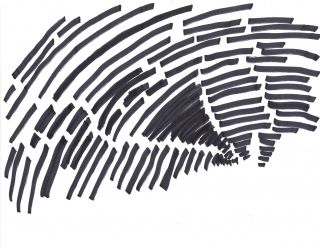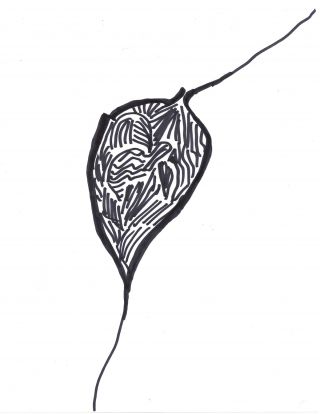Health
Using Art Therapy to Re-Author the Dominant Narrative of Illness
Art helps us makes meaning when confronted by life-threatening illness.
Posted June 5, 2012
I have just completed an edited book on the various applications of art therapy and art making in health care settings. In working on this book, I recalled many children and adults living with serious or chronic illnesses or physical challenges that I have encountered in art therapy sessions over the last two decades. Many have had cancer, others have struggled with autoimmune illnesses like

Buddha Blossom, mixed media collage by Michaela
rheumatoid arthritis; some have had to adjust to traumatic brain injury, paraplegia or chronic pain due to accidents, disasters or war. While each has had a lasting impact on me, one individual’s story in particular comes to mind because it eloquently summarizes how art therapy makes a difference in the lives of people confronted with a medical illness or physical disability.
At the age of 43, Michaela was diagnosed with ovarian cancer. For most of her adult life she was a triathlon athlete and a self-proclaimed “health nut” who was careful about her diet and health; she was also nurse who worked in the adult oncology unit and assisted in surgery at a university hospital. Because of her medical background as a nurse Michaela knew in great detail what a diagnosis of ovarian cancer meant and the challenges that were ahead of her, including treatment that would be physically exhausting and often toxic in order to rid her body of cancer. When I met her for our first few art therapy sessions, Michaela explained to me that she wanted to include art making and creative writing as part of her treatment. She jokingly referred to her illness as “cancer schmancer,” maintaining a uniquely positive attitude during what were months of debilitating side effects of chemotherapy and fatigue resulting from radiation. From the outset, Michaela committed herself to do whatever possible to treat not only the disease, but also to explore the “psycho-social-spiritual” effects of the illness on mind and body with everything available including art therapy.

Michaela's anger drawing
Michaela had never considered herself a creative person but she decided to risk expressing herself in art and writing as a way to cope with her diagnosis, medical interventions, medications and changes in her life. In initial sessions we focused on the feelings she had about her cancer diagnosis through drawings and collage. One of the first images Michaela created was a drawing of her anger; for the first time in her life she felt deeply angry, even questioning and blaming herself for her illness despite her own medical knowledge about ovarian cancer. While she felt uncomfortable expressing this anger to even her closest family members and friends, drawing and writing about her feelings provided ways to acknowledge feelings, put her emotions into perspective and release some of the stress associated with the challenges of being a patient for the first time in her life. We also explored the growing depression she was experiencing and how well she hid it from family, friends and colleagues at the hospital. When we discussed the content of this particular drawing Michaela immediately recognized how well she disguised her depression, keeping it deep inside herself, and how the lines in this art expression mimicked those in her anger drawing. These early art expressions became the basis for a series of larger drawings and paintings that Michaela eventually exhibited at the local Gilda’s Club, a support program for cancer survivors, where she also shared her creative writing about her experiences with other patients and families.
A year after surgery, chemotherapy and radiation treatments, Michaela’s cancer went into remission. She began long distance running again, took on more responsibilities at work and became more hopeful about her prognosis because there was no evidence of cancer according to tests. The remission was short-lived and nine months later her cancer returned in an inoperable Stage 4 form in her liver and lungs. Right after this recurrence her husband of 13 years decided that he did not want to remain in a marriage to a terminally ill wife and filed for divorce. As Michaela said, “things really have hit rock-bottom” and she subsequently experienced a month of severe grief reactions and depression due to the divorce and her prognosis. Fortunately, she had extensive social support from family and friends who were available to help Michaela during the inevitable progression of the cancer and the loss of a primary relationship. In many art therapy sessions during this time she depicted what she called the “struggle between life and death” and we talked about the process of dying and if there was indeed an afterlife, soul or spirit. Art making and writing strengthened Michaela’s resolve to find peace from any lingering anger and sadness about simultaneously having cancer and enduring a divorce.
As Michaela became more physically debilitated, her visits to my office became too exhausting and I brought art materials to her apartment. In these final sessions before she became too ill to participate, I helped Michaela organize her writing journals and create colorful binders for them. She

Michaela's drawing of depression
also continued to make art, working on what she called an “inner sense of compassion” for herself that she eventually symbolized in a small mixed media collage piece called “Buddha Blossom.” Michaela created a hand drawn image of a brilliant yellow, orange and red rose blooming and placed it on a background that she said represented the cancer cells overtaking her body. In brief, she depicted her transformation into someone who was no longer a cancer patient; she was able to leave cancer behind and make peace with both the divorce and the process of dying.
Michaela’s story is both compelling and inspiring to all those who confront mortality when living with a diagnosis of cancer or other condition. From working with Michaela, I learned much of what I now believe about the role of art expression as therapy for individuals and families with life-threatening or chronic illness. Michaela and I never discussed art therapy as a “cure” for her cancer, but we often talked about how her creative expression through art and writing were part of her “healing” in the sense of coming to terms with her illness, a divorce and eventually the process of dying. After Michaela died peacefully at home with her family and hospice care at bedside, I continued to work with her parents and her brother to help them through their grief. A large part of our family sessions were not only focused on commemorating Michaela’s life through art expression, but also in collecting, reviewing and framing many of the artworks she created during art therapy. Her writing journals became a treasured legacy and a record of a life well lived and well loved by family, friends and colleagues.
The creative process of art making within the context of therapy provides an experience that is not clearly categorized as psychosocial, rehabilitative or health-giving. In brief, it is art therapy’s ability to provide patients with the chance to re-author the dominant narrative of their illness or physical disability and provide a way to explore what is referred to as “posttraumatic growth.” Returning to Michaela’s story and as a person with cancer, art therapy ultimately not only became a way to find meaning and express the story of her experiences with a cancer diagnosis, treatment and the process of death and dying, but also provided a medium for reframing her cancer narrative. Art expression often becomes a pathway for transforming feelings and perceptions into a new life story and, as a result, creating a new sense of self. This “re-authoring” of one’s life story may be different for each person, and it often includes one or more of the following aspects: development of new outlooks; discovery of answers to the unanswered questions; revisions in the way one lives life; creation of solutions or a resolutions to personal struggles; creation of a new “post-illness” identity; or discovery of an explanation for why one’s life has been altered by illness, disability, or physical trauma. It is a form of “meaning making” that can be ultimately helpful in an individual’s adjustment and acceptance of serious or life-threatening conditions.
Cathy Malchiodi, PhD, LPCC, LPAT
© 2012 Cathy Malchiodi


